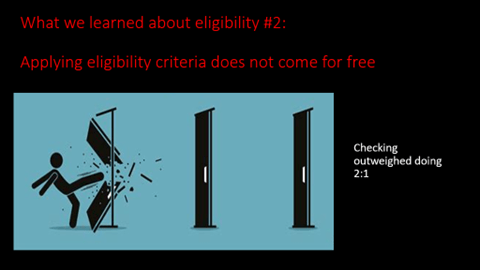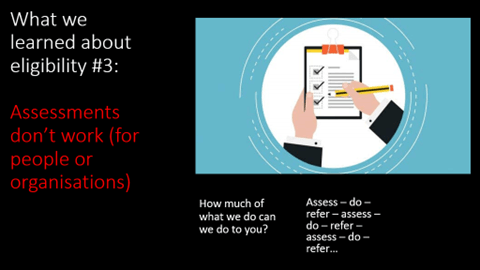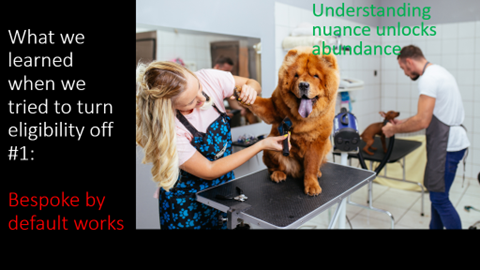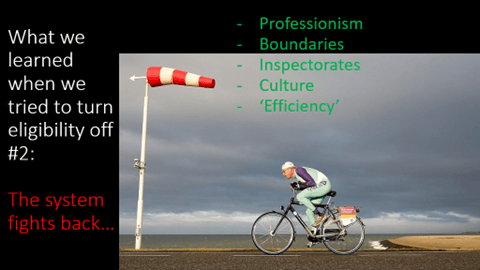Eligibility criteria – what if we just turned them off?
Eligibility criteria are one of the most damaging features of the current design of public services. They create more demand, introduce waste/non-value work and stymie creativity. If I could, I’d turn them off tomorrow.
Problem is, we’re awash with them. They, and their trusty companions assessments and signposting, are so much a part of the furniture that we don’t see it, any more than fish see water. It’s the sea we swim in.
The logic is plausible. By making it harder to access services, we can use what little resources we have supporting those that need it the most. “Come back when you’re worse”, we say.
One of the reasons I wanted to bid into Changing Futures was to debunk this. To disrupt this thinking, perhaps to pollute the water so the fish can see it.
Why though? Over the last ten years or so, I have been learning how to support people in a more bespoke fashion. To do this, we had to understand why people who were having a hard time weren’t getting the support they needed and what better might look like. We learned a bunch of things...
One - Eligibility criteria increase demand

I studied the history of the highest consumers in various systems including adults social care, hospitals, housing and the criminal justice system. I found that between 50% and 75% of the higher consumers of resources had at some point been screened out for essentially not being in a bad enough way.
This means the level of acuity of demand that does make it through is higher and the suffering across the population is greater. It also bunches demand up so it hits in waves. It’s very hard to deal with. The intended brake has become an accelerator.
It increases demand. There’s more to do because we weren’t engaging earlier. Our mindset was scarcity and rationing, not creativity and abundance.
If we are asked earlier, or see a signal sooner, surely we can use this to create something proportionate and bespoke with people, their families, communities? This is precisely what we are doing at Changing Futures Northumbria.
Two – Applying eligibility criteria does not come for free

When people who have ‘bounced’ in and out of assorted services have consented to have their back story studied, we can see how their interactions with multiple agencies form patterns. Key amongst these were the ratio of ‘checking’ (assessments, panels, scrutiny, supervisory oversight/justification, inspection etc) to ‘doing’ (supporting, nurturing, connecting...even intervening) was roughly 2:1.
The systems we have in place devote a lot of resources to managing the resources. A de-facto purpose emerges, which is to create and maintain a defendable position (otherwise known as ‘cover your arse’).
Imagine if we could liberate the time and effort spent doing this to doing other things...
Three – Assessments don’t work (for people or organisations)

Assessments are for us. Not for people. They are our way of answering the question, “How much of what we do can we do to you?” They fall short of understanding because they are not there for that purpose.
Because assessments are concerned with issues up front around eligibility and justification, they don’t explore context. They aren’t concerned with nuance. The people that do them are, but one reason morale in the health and social care system is low is because the means of assessment vary profoundly from their spirit of enquiry and support, the reasons they got into this work.
Assessments are a way into packages, pathways and protocols. They result in either a screen out (come back when you're worse), a referral (“go and have an assessment over there...”) or some action, which will be a package or pathway about the bits of your story that fit the service boundary. If you need more, you’ll need to have a different assessment and more referrals.
The current system is essentially a series of specialities connected by referral pathways. There is no subtlety or craft about a person’s own story or aspirations. If tyranny is the destruction of nuance, then this system is downright tyrannical.
Four – Bespoke by default works better

Sick of trying to bypass and fudge these criteria, we tried turning them off through a series of protected prototypes. We wanted to see if the sky would fall in if we helped people without screening them. Could pursuing a bespoke by default approach be more effective? Would this in turn reduce demand make things more sustainable?
We stopped screening people and just helped when they presented or if we approached people based upon intelligence (such as unpaid council tax). We dropped assessments (no need for them if you aren’t screening) and looked instead to understand. We learned that nuance matters to people as it supplies faith that engaging will work for them and it will less likely traumatise them further.
We learned that for one lady we got to know, dog grooming was the answer to building her confidence and helping her to thrive on her terms. For others, it was about simply having food in the house before even thinking about anything beyond today. People are stories, and knowing these stories gave more agency and currency to help than any assessment I'd ever seen in my whole career. People were helped out of decades-long slumps because they were understood, and time was invested in them. Assess-do-refer is surely dead?
Five – The system fights back...

Of course, we know this right? When you go person-shaped, you stop going service-shaped, organisation-shaped, professional boundary-shaped...and it feels threatening.
By buying a young woman a coat because it was December and she was freezing, we were accused of creating a dependency, told we ‘Couldn’t buy everyone coats’ (of course, we weren’t suggesting we did). We were told that the inspectors would look dimly on us for this. That is was a waste of money (£16).
She ended up telling us why she didn’t have a coat, why she was cold, scared and eventually disclosed things which meant she could move on with her life and some justice and closure achieved. We didn’t do a coat assessment. We were pilloried for this. But no-one in the various systems of care and support knew what we knew and trust was critical. We were discouraged from exploring nuance. But it was nuance that helped us to be alongside in a helpful way.
So how can we ever create a system where we can turn them off?
This is the hard part. Taking these things down in one area will flood it, so we need to create abundance and support for future demand that wouldn't yet make it in.
We’ve studied the root cause of the various systemic features that enable and prop up the eligibility model. These are the points of leverage that need working upon to normalise understanding over assessing and that ultimately could lead to turning such features off.
Changing Futures Northumbria is not going to screen or assess. We’ll use intelligence and data to find and help people by understanding them. This will not only create a case for turning them off but it will create a path towards how to move from scarcity and abundance by embracing the power of people’s own stories and what matters to them.
We know the answer to doing this lies across regulation that allows for more creativity, commissioning so that all sectors can invest in delivery and learning, new generalist roles that have genuine status, better measures that focus on efficacy, and using data better to get upstream of problems that are predictable. We’ll focus on articulating these things in more and more detail as this work progresses, but for now, we are wedded to the overriding principle that everyone is eligible to be understood.



